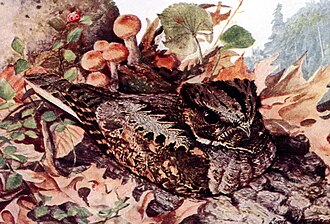Difference between revisions of "Field Guide/Birds/Caprimulgus vociferus"
(fixed a 404 on the sound link, wiki markup error) |
m (58 revisions: re-import from WB, including edit history) |
||
| (30 intermediate revisions by 5 users not shown) | |||
| Line 1: | Line 1: | ||
| − | {{ | + | {{Bird id |
| − | |||
| name = Whip-poor-will | | name = Whip-poor-will | ||
| − | | | + | | latin_name = Caprimulgus vociferus |
| − | | | + | | image_1 = Caprimulgus_vociferusAAP065B.jpg |
| − | | | + | | caption_1 = Whip-poor-will |
| − | | | + | | level = 4 |
| − | | | + | | description = The '''Whip-poor-will''' or '''whippoorwill''', ''Caprimulgus vociferus'', is a medium-sized (22-27 cm) nightjar, a type of nocturnal bird. The Whip-poor-will is commonly heard within its range, but less often seen. It is named after its call. |
| − | |||
| − | |||
| − | |||
| − | |||
| − | |||
| − | |||
| − | |||
| − | The '''Whip-poor-will''' or '''whippoorwill''', ''Caprimulgus vociferus'', is a medium-sized (22-27 cm) | ||
| − | |||
Adults have mottled plumage: the upperparts are grey, black and brown; the lower parts are grey and black. They have a very short bill and a black throat. Males have a white patch below the throat and white tips on the outer tail feathers; in the female, these parts are light brown. | Adults have mottled plumage: the upperparts are grey, black and brown; the lower parts are grey and black. They have a very short bill and a black throat. Males have a white patch below the throat and white tips on the outer tail feathers; in the female, these parts are light brown. | ||
| − | + | The Whip-poor-will's breeding habitat is deciduous or mixed woods across southeastern Canada, eastern and southwestern United States, and Central America. They nest on the ground, in shaded locations, among dead leaves, and usually lay two creamy eggs. This bird does not normally flush from the nest unless it is underfoot. | |
| − | The Whip-poor-will's breeding habitat is deciduous or mixed woods across southeastern | ||
| − | Northern birds | + | Northern birds migrate to the southeastern United States and south to Central America. Central American races are largely resident. |
These birds forage at night, catching insects in flight. They normally sleep during the day. | These birds forage at night, catching insects in flight. They normally sleep during the day. | ||
| − | + | }}<noinclude>[[Category:Adventist Youth Honors Answer Book/Transcluded Modules|{{FULLCHAPTERNAME}}]]</noinclude> | |
| − | |||
| − | |||
| − | |||
| − | [ | ||
| − | |||
| − | |||
| − | {{ | ||
| − | |||
| − | |||
| − | |||
| − | |||
| − | |||
| − | |||
| − | |||
Latest revision as of 20:11, 5 July 2012
| Caprimulgus vociferus (Whip-poor-will) | |
|---|---|
| Description | |
| The Whip-poor-will or whippoorwill, Caprimulgus vociferus, is a medium-sized (22-27 cm) nightjar, a type of nocturnal bird. The Whip-poor-will is commonly heard within its range, but less often seen. It is named after its call.
Adults have mottled plumage: the upperparts are grey, black and brown; the lower parts are grey and black. They have a very short bill and a black throat. Males have a white patch below the throat and white tips on the outer tail feathers; in the female, these parts are light brown. The Whip-poor-will's breeding habitat is deciduous or mixed woods across southeastern Canada, eastern and southwestern United States, and Central America. They nest on the ground, in shaded locations, among dead leaves, and usually lay two creamy eggs. This bird does not normally flush from the nest unless it is underfoot. Northern birds migrate to the southeastern United States and south to Central America. Central American races are largely resident. These birds forage at night, catching insects in flight. They normally sleep during the day. | |

